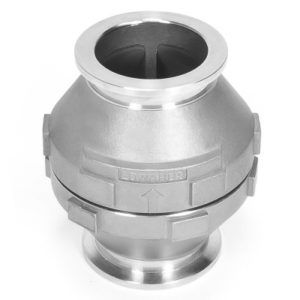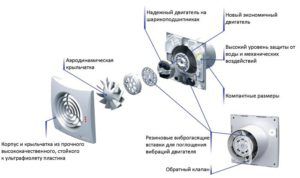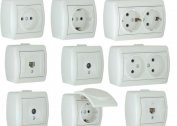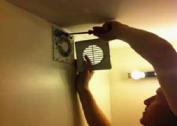Good ventilation helps prevent dampness, mold and unpleasant odors in the room. If weak draft is observed in the natural ventilation system, then it must be equipped with a duct fan.
An urgent problem in apartment buildings is the distribution of odors through the ventilation duct from neighboring apartments. In such cases, it is necessary to prevent air backflow when the fan is off. An effective solution to problems associated with poor draft and odors in the apartment is an exhaust fan with a check valve. This device is intended for use in such rooms:
- in the bathroom;
- on the kitchen;
- in sanitary compartments;
- in smoking rooms;
- in public laundries;
- in sports halls, libraries equipped in basements, etc.
Thanks to the non-return valve, dust, debris and air from the ventilation duct do not enter the housing. This device is especially good in cases where the apartments of the house are equipped with waste bins.
Types of valves
Concepts such as backdraft and check valve have a close relationship. If you install the hood in the kitchen and turn off the equipment in the winter, a strong back draft will occur: the cold air from the street will enter the room and cool it. And if you install a fan with a check valve in the hood, then the situation will radically change for the better.
There are three types of check valves:
- With electric or manual control.
- Self-locking (on spring).
- Passive (position change is carried out only under the influence of direct or reverse flows).
In addition, devices with a non-return valve are divided into the following types:
- household;
- ventilation diffusers;
- round or square duct fans.
Managed
 Valves, which are powered by electricity, are indispensable equipment for the automation of large facilities. The fan with a controlled valve is equipped with an angle sensor for the damper. This allows you to observe what is happening at the most distant end of the warehouse or workshop. Thus, thanks to the electric non-return valve, the formation of mold, high humidity, a musty odor, as well as the penetration of rain and snow into the room from the street, is prevented. In industrial plants, such fans help keep raw materials and products intact. It should be noted that many modern household models also run on electricity.
Valves, which are powered by electricity, are indispensable equipment for the automation of large facilities. The fan with a controlled valve is equipped with an angle sensor for the damper. This allows you to observe what is happening at the most distant end of the warehouse or workshop. Thus, thanks to the electric non-return valve, the formation of mold, high humidity, a musty odor, as well as the penetration of rain and snow into the room from the street, is prevented. In industrial plants, such fans help keep raw materials and products intact. It should be noted that many modern household models also run on electricity.
Self-locking
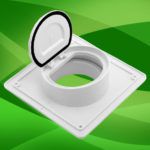 For the ventilation of the bathrooms a fan is used, equipped with a valve on the spring. To open it, the fan needs to expend some energy, which leads to a decrease in efficiency. But at the moment the blades stop, the spring immediately affects the valve, and it closes. And, although it does not close tightly, this is enough to protect the housing from the unpleasant odors present in the ventilation shaft.
For the ventilation of the bathrooms a fan is used, equipped with a valve on the spring. To open it, the fan needs to expend some energy, which leads to a decrease in efficiency. But at the moment the blades stop, the spring immediately affects the valve, and it closes. And, although it does not close tightly, this is enough to protect the housing from the unpleasant odors present in the ventilation shaft.
Keep in mind that fans equipped with a non-return valve operate more noisily than conventional fans.
Passive
 These devices work due to the force of gravity, because their wings are closed by gravity. Sometimes passive check valves are used for installation in the kitchen, but they are considered less popular compared to spring models.
These devices work due to the force of gravity, because their wings are closed by gravity. Sometimes passive check valves are used for installation in the kitchen, but they are considered less popular compared to spring models.
Check valve design
For the manufacture of domestic fans, primarily plastic is used. Industrial are made of metal and are distinguished by greater cost, power and weight.The check valve fan is a structure that consists of:
- Housings.
- Impellers.
- Engine.
- Check valve.
The check valve is made of such parts:
- Body.
- Flaps rotating on an axis.
- Bounding semicircular protrusions.
- Return torsion spring designed to push the flapper back in place while the fan is shutting down. This element is present only on self-closing valves.
The principle of operation of the check valve
Devices with a non-return valve can take only two positions - closed and open.
- In the closed position, the sash rotates perpendicular to the nozzle, closing the air inlet.
- In the open - takes a parallel position to the nozzle, without obstructing the movement of air.
Thanks to the limiters, made in the form of protrusions, the sash can be rotated only 90 degrees. After turning on the fan, the system is in the open position. When the device is turned off, the sash closes, turning 90 degrees. The flow movement strictly in one direction is due to the fact that the axis is not located in the center of the pipe.
Models running on springs are the most common in everyday life. However, they are also used in production. So, the Shuft RSK model, designed for industrial use, has two spring leaves located on the diametrical axis. The valves are made in the form of semicircles having one common straight side. When the fan is turned off, the system closes, when turned on, both folds are located in the middle, opening the air flow. This design is made of galvanized steel and has a fairly large weight.
In channel-type flap valves, a damper mounted in the duct resembles a gate that prevents rain and cold from entering the housing. For installation in the kitchen are often used flap valves "Tulip", which have another name - inertial gratings.
These designs are a rectangular frame with horizontal bars integrated inside. Their opening is facilitated by the flow of the fan, and when the air supply is cut off, the sashes close under their own weight. Petal valves operating on this principle are called gravity valves.
When installing the petal gravity valve in the bathroom, toilet or kitchen, you must choose a fan that has sufficient power.
How to choose the right model?
When purchasing a fan, it is recommended to take into account the following indicators:
- The volume of the room. First of all, you should determine the volume of the room. To do this, multiply the length of the room by its width and height. Further, the obtained indicator is multiplied by a value that determines the multiplicity of air exchange in the room. This value is equal to the number of times the air exchange in the room for a certain period of time. So, in the bathroom and shower air should change about 3-8 times in one minute. Thus, when choosing a fan for a bathroom with a non-return valve, you need to know that its power must be at least 65 W if the volume of the bathroom is 21 m³. This power is enough for a minimum number of times of air exchange - 3 times. To achieve the maximum value of 8 times, the fan power for a room with a volume of 21 m³ should be at least 175 watts.
- Safety. Steam generated in the kitchen during cooking, as well as in the bathroom while taking a shower, can cause electric shock. Therefore, it is advisable to purchase low-voltage models designed for a voltage of not more than 12-24 watts.
- Noise level. Any fan model makes noise during operation. Therefore, to prevent the occurrence of uncomfortable sensations, attention should be paid to structures with reduced noise levels.
- Availability of additional options. Today on the market you can find models of fans equipped with a timer, motion and humidity sensors, constant ventilation mode, operating at minimum speed, and even a clock on the front panel. In addition, for the bathroom and kitchen, you can choose a device with protection against splashing water and grease. However, it should be borne in mind that such models are more expensive than conventional fans.
A ventilation device with a non-return valve is an indispensable thing for people suffering from allergies or asthma, since such designs not only prevent the penetration of tobacco smoke and smells from neighbors into the apartment, but also clean the room itself from existing odors.
